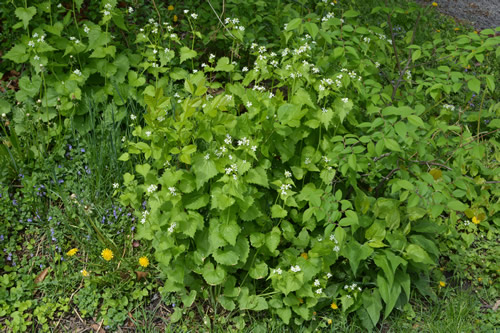Issue 2, May 5, 2020
Garlic Mustard
While walking in my neighborhood, I spotted a single blooming garlic mustard reaching for the sun in front of a yew hedge. Knowing there can’t be just one, upon further investigation, I found a larger patch growing the shade behind the yews. Garlic mustard is a weed that must be controlled now, not later. Garlic mustard is an invasive weed that wreaks havoc in our natural areas choking out native plants. The roots of this plant exude a chemical that inhibits the growth of plants around it. This plant can be found in full sun or full shade. Each plant is capable of producing thousands of seeds. Illinois Wildflowers says, “At the present time, Garlic Mustard is the worst herbaceous invader of deciduous woodlands in Illinois as it has the capacity to crowd out and destroy all of the native wildflowers that bloom during the spring.”

Figure 1 Garlic Mustard Alliaria petiolata
Garlic Mustard is a biennial. During the first year of grown, the plant produces a rosette of heart-shaped leaves with coarse, round, irregular teeth on the margins. The following spring, the plants send up a 1-2-foot flowering stalk of small, four-petaled, white flower clusters. It smells intensely of garlic.

Patch of Garlic Mustard (Alliaria petiolate)
Seeds disperse when the seedpods burst at maturity in August. Seeds have a 20-month dormancy period and do not germinate until the second spring after ripening. Some plants produce as many as 8,000 seeds! Rhonda Feree, former Extension horticulture educator states, “The goal of any garlic mustard control program is to prevent seed production until the seed bank is exhausted, usually a two to five-year period. I cannot emphasize the importance of not letting this plant go to seed!”
For forest management, spring and fall burns or spot treatment of glysophate are recommended by the Illinois Natural History survey. However, for a garden or landscape setting, hand pulling is the best method and can greatly reduce the population. It is important to scout the following years as you may already have a viable seed in the soil.
Kelly Estes states “cutting the stalk as close to the soil surface as possible as flowering begins may also be effective. Larger infestations may require chemical applications (glyphosate). Recommended treatments times are late fall or early spring as this is a nonselective herbicide and most other plants are dormant during this time frame.”
For more information, stop by the Illinois CAPS blog for all the latest news on invasive pests in Illinois.
Author:
Kelly Allsup